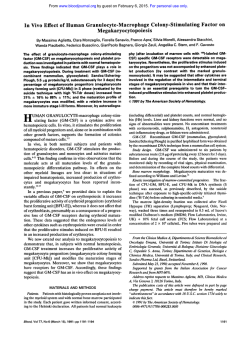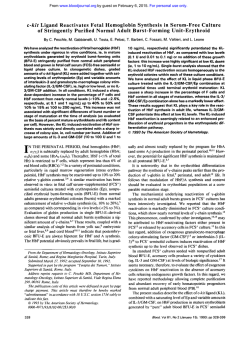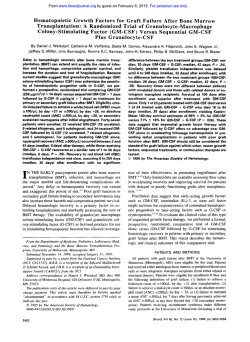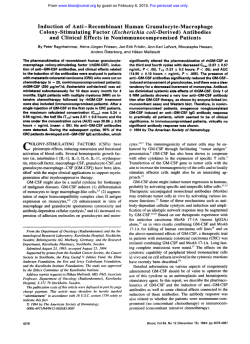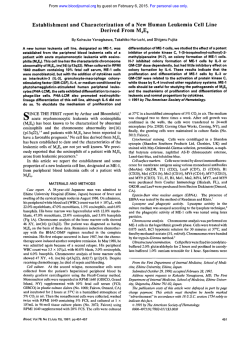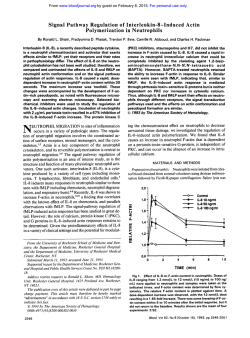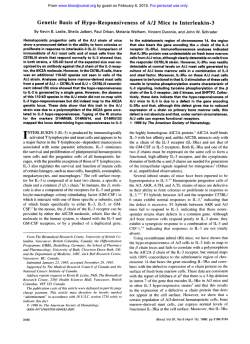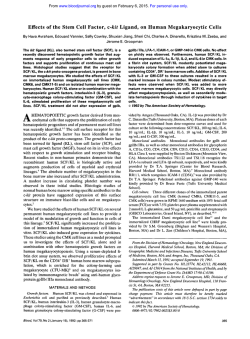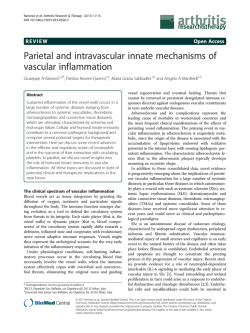
Neutrophils Activated by Granulocyte-Macrophage Colony
From www.bloodjournal.org by guest on February 6, 2015. For personal use only.
Neutrophils Activated by Granulocyte-Macrophage Colony-Stimulating
Factor Express Receptors for Interleukin-3 Which Mediate
Class I1 Expression
By William B. Smith, Laura Guida, Qiyu Sun, Eija 1. Korpelainen, Cameron van den Heuvel, David Gillis,
Catherine M. Hawrylowicz, Mathew A. Vadas, and Angel F. Lopez
Freshly isolated peripheral blood neutrophils, unlike monocytes and eosinophils, do not bind interleukin-3 (IL-3) or respond t o IL-3. We show that neutrophils cultured for 24
hours in granulocyte-macrophage colony-stimulating factor
(GM-CSF) express mRNA for theIL-3 receptor (R) a subunit,
as shown byRNase protection assays, and lL-3Rn chain protein, as shown by flow cytometric
analysis using t w o different specific monoclonal antibodies. This effect wasselective
for GM-CSF, because granulocyte colony-stimulating factor,
tumor necrosis factor-a, interferon-?, and IL-l failed t o induce the IL-3 receptor. Saturation binding curves with ’251IL-3 and Scatchard transformation showed thepresence of
about 100 high-affinity and4,000 low-affinity receptors. Because neutrophils have been shown t o express human leukocyte antigen (HMI-DR in response t o GM-CSF, we examinedthepossibilitythat
IL-3 could
augment
HLA-DR
expression on GM-CSF-treated cells. We found thatneutrophils incubated with 30 ng/mL IL-3 as well as 0.1 ng/mL GMCSF expressed a mean of 2.1-fold higher levels of HLA-DR
than with GM-CSF alone ( P < .005),confirming thesignatling
competence of the newly
expressed IL-3R. This increase was
seen even at maximalconcentrations of GM-CSF and represents the first demonstration that GM-CSF and IL-3 can have
an additive effect on mature human
cells. The augmentation
of HLA-DR by IL-3 was specific because it could be inhibited
by a blocking anti-IL-BR antibody. Expression of class II molecules by neutrophils under these conditions may have significance for antigen presentation.These results providefurther evidence for the role of GM-CSF as an amplification
inducing neutrophil responfactor in inflammationby
siveness t o IL-3 produced by T cells or mast cells.
0 1995 by The American Society of Hematology.
N
specificity.’ Both chains are necessary for high-affinity binding and signalling.8 Neutrophils bind GM-CSF withhigh
affinity, implying that they express the GM-CSF receptor a
and p chains on the cell surface. On the other hand, the lack
of binding of IL-3 suggests that neutrophils do not express
the IL-3Ra chain. Using receptor subunit-specific monoclonal antibodies (MoAbs), RNase protection, and binding
assays, we show here that, although IL-3R expression is
undetectable on freshly obtained neutrophils from healthy
donors, it is selectively induced after incubation with GMCSF. Furthermore, IL-3 is shown to act in synergy with GMCSF in the induction of human leukocyte antigen (HLA)-DR
on human neutrophils. These results show that, in addition to
directly stimulating neutrophil function, GM-CSF can render
neutrophils responsive to IL-3, thus further amplifying their
activation.
EUTROPHILIC LEUKOCYTES are essential to host
defence, and their function is regulated, at least in part,
by various soluble factors. The hematopoietic growth factors
granulocyte-macrophage colony-stimulating factor (GMCSF) and granulocyte colony-stimulating factor (G-CSF) are
known to be important in stimulating the production and the
functional activation of mature neutrophils.’ Interleukin-3
(IL-3) is a related growth factor that has been shown to
stimulate and prolong survival of mature eosinophils, monocytes, and basophils* and, recently, to stimulate endothelial
cells.’ However, unlike GM-CSF and G-CSF, IL-3 stimulates the production of neutrophils from bone marrow precursors but is unable to stimulate the function of these cells in
short-term assays: suggesting that the IL-3 receptor (R) is
lost during differentiation of the neutrophilic ~ e r i e sConsis.~
tentwith these findings, neutrophils freshly isolated from
healthy donors were shown not to bind IL-3.6 However, in
a system in which neutrophils were cultured for several days,
a weak upregulation of class I1 by IL-3 was seen, suggesting
that receptors might be re-expressed.’
The heterodimeric receptors for GM-CSF, IL-3, and IL-5
are structurally related and share a common /3 chain (pc),
whereas the a chains are unique to each factor and confer
From the Department of Immunology, St Mary’s Hospital Medical
School, London, UK; and the Division of Human Immunology, Hanson Centre for Cancer Research, Adelaide, South Australia.
Submitted May 5, 1995; accepted July 13, 1995.
Supported in part by the Wellcome Trust, UK. W.B.S. was supported by a Postgraduate Research
Scholarship and the C.J. Martin
Postdoctoral Fellowship from the National Health and Medical Research Council (Australia). L.G. was supported bythe Arthritis and
Rheumatism Council of Great Britain.
The publication costsof this article were defrayedin part by page
chargepayment. This article must therefore be hereby marked
“advertisement” in accordance with I8 U.S.C. section 1734 solely to
indicate this fact.
0 1995 by The American Society of Hematology.
0006-497//95/8610-0025$3.00/0
3938
MATERIALSAND METHODS
IL-3 (human recombinant) was a kind gift of Genetics institute
(Cambridge, MA) and had a specific activity of 0.17 U/ng. GMCSF (human recombinant) from two sources was used (gifts were
from Dr A. O’Garra [DNAX, Palo Alto, CA] and Genetics Institute)
with a specific activity of 50 Uhg. G-CSF (human recombinant)
was obtained from Amgen (Thousand Oaks, CA).
MoAbs. MoAb against the IL-3Ra chain (9F5), the GM-CSFRa
chain (8G6), and pc (4F3) were raised and characterized as previously described.’,’ Purified antibodies (IgG1) were used at a final
concentration of 1 pg/mL for staining cells. The control antibody
was purified (nonimmune) mouse IgGl (Becton Dickinson, San Jose,
CA). Blocking IL-3Ra antibody 7G3 (IgG2a) was raised and characterized as described.’“
Anti-HLA-DR (L243), anti-HLA-DP (B7/21), and anti-HLADQ (SPVL3), which were gifts from Dr H. Spits (Netherlands Cancer Research Institute, Amsterdam, The Netherlands), were purified
and conjugated to fluorescein isothiocyanate (FITC) in the deparment using standard methods.” The control antibody was FITCconjugated IgG2a (Dako, Bucks, UK).
Anti-CD16, conjugated to phycoerythrin (PE) or unconjugated,
was a mouse IgG2a clone CLB-149 purchased from Eurogenetics
Blood, Vol 86,No 10 (November 15). 1995:pp 3938-3944
From www.bloodjournal.org by guest on February 6, 2015. For personal use only.
3939
NEUTROPHIL IL-3 RECEPTORS
(Teddington, UK). Anti-CD9 was purchased from the Binding Site
(Birmingham, UK).
Neutrophilisolation and cellculture. Heparinized blood from
healthy volunteers was diluted 1:l with RPMI 1640 (Sigma, Poole,
UK) and separated byFicolVHypaque (Nycomed, Oslo, Norway)
gradient centrifugation. Red blood cells were lysed in ice-cold isotonic (155 mmol/L) ammonium chloride solution. Purity of preparations was greater than 95% neutrophils as judged by morphologic
examination of Wright's-stained cytocentrifuge preparations. Contaminating cells were mostly eosinophils.
For higher purity, neutrophils were prepared in some experiments
by centrifugation of blood over a Percoll (Sigma) solution with a
density of 1.082 g/mL (for improved separation from mononuclear
cells). The granulocytes were incubated with anti-CD9 antibody (1
pg/mL), which binds to eosinophils and not neutrophils, and then
with sheep antimouse-coated magnetic beads (10 beads/eosinophil;
Dynabeads; Dynal, Oslo, Norway). The eosinophils bound to the
beads were then removed with a magnet. This yielded neutrophil
preparations of greater than 98% purity. In other experiments, where
indicated, neutrophils were purified using metrizamide (Nycomed,
Oslo, Norway) multistep gradients, as described," and were also
greater than 98% pure.
Neutrophils were cultured in 24-well (lo6 ceIls/well) or 96-well
( IO5 celldwell) tissue culture dishes (Nunc, Roskilde, Denmark) in
RPMI 1640 (GIBCO, Life Technologies, Paisley, UK) with 5% fetal
calf serum (FCS; Sigma), penicillin/streptomycin, and glutamine
(GIBCO). TF1 cells" were maintained in RPMI 1640 medium containing 10% FCS and recombinant GM-CSF at 2 ng/mL.
Flow cytometry. All flow cytometric analysis was performed
using an EPICS Profile I1 cell analyzer (Coulter Electronics Ltd,
Luton, UK). Neutrophils were prepared for flow cytometry by washing in phosphate-buffered saline (PBS) with 1% bovine serum albumin (BSA; Sigma) and 0.1% sodium azide and then incubated with
5% human AB serum (Sigma) or 5% rabbit serum (Sigma) on ice
to block Fc receptor-mediated binding of MoAbs. Neutrophils were
then incubated with saturating concentrations of MoAb on ice for
20 minutes. Directly stained cells were then either read immediately
or fixed in PBS/0.4% formaldehyde/2% glucose/O.O2% sodium azide
for later reading; indirectly stained cells went through a further
incubation with FITC- or PE-conjugated goat antimouse antibody
(Dako) diluted in PBS/BSA/azide with 2% goat Ig (Sigma). For dualstaining, cells were initially stained indirectly as described above and
then underwent a further blocking step in 5% mouse serum before
being incubated with directly conjugated antibody.
Neutrophil preparations labeled indirectly for receptor expression
were generally examined after approximately 20 hours of culture
and were gated for live cells by forward and side scatter criteria.
Neutrophils examined for major histocompatability complex (MHC)
class I1 expression after approximately 40 hours of culture were
dual-stained with CD16 antibody/goat antimouse PE and FITC-conjugated antibodies to HLA-DR, DP, and DQ. HLA expression was
determined on cells gated for high CD16 expression.
Results are generally expressed as the mean fluorescence intensity
(Mm) of the entire (gated) cell population in linear units (histograms
shown have a logarithmic scale). Background (negative control antibody, isotype-matched) fluorescence was subtracted in some of the
figures, as indicated in the legends.
Binding of '"iodine-labeled IL-3 ('2sl-IL,-3). Recombinant k3 was labeled with '1 using the iodine monochloride method.13
Freshly labeled L 3 was incubated with 2 X lo6 neutrophils per
point for 3 hours at 22°C in medium containing 0.1% sodium azide
(binding medium). Specific binding was established by subtracting
the counts per minute (CPM) from parallel samples containing 100fold excess unlabeled IL-3. The Scatchard transformationL4was derived from a saturation binding curve using 3 X lo6 neutrophils
B
A
Lop Fluorercence InI*nsiIy
Log Fluorarcenc. Inl.nsily
Fig 1. Flow cytometry shows expression of a-chain subunits for
the GM-CSF and 11-3 receptors. Neutrophils were freshly isolated
(A
and B) or cultured overnight 120 hours) with medium alone (C and
Dl or GM-CSF l nglmL (E and F). Cells were stained with negative
control antibody mouse lgG1 (solid
lined, anti-GM-CSFRa MoAb
866 (dashed lines; A, C, and E), and anti-IL-SRm MoAb 9F5 (dashed
lines; B, D, and F). The cells were dual-stained with CD16 and gated
for high expression. Single-donor neutrophils, representative of
7 to
9 donors; for pooled fluorescemce values, see Fig 2.
(metrizamide preparation, >98% pure) in triplicate per point and 10
pmol/L to 30 n m o m IL-3.
RNase protection assay. Total cellular RNA was isolated from
purified neutrophils using guanidinium thiocyanate." A 10 pg sample of total RNA was analyzed by RNase protection assay, as previously described,I6except that only RNase A was used (20 pg/mL)
and that the glyceraldehyde-3-phosphate dehydrogenase (GAPDH)
probe used as an internal control was synthesised at a lower specific
UTP at 4 Cilmmol. For probe synthesis, ILactivity using [cY-~*P]
3Ra chain cDNA was subcloned into pGEM2 and GAPDH cDNA
into Bluescript KS. The probes protect the following fragments of
the mRNA, with enzymes used tolinearize the transcription template
shown in parentheses: 1119-1280 (PS?I) for IL-3Ra chain and 707810 (Sty I) for GAPDH. Gels were quantified by ImageQuant analysis (Molecular Dynamics, Menlo Park, CA), with GAPDH being
used as an internal control.
RESULTS
Expression of receptors for K - 3 and GM-CSF on resting
and
activated
neutrophils. Neutrophils freshly isolated
from healthy donors clearly expressed flow cytornetrically
detectable levels of GM-CSFRa (Fig lA), whereas the profile for IL-3Ra was indistinguishable from that of the control
antibody (Fig 1B). ,Bc was also detectable withaprofile
similar to that of GM-CSFRa on fresh cells (data not shown).
From www.bloodjournal.org by guest on February 6, 2015. For personal use only.
SMITH ET AL
3940
N=9
N=7
Fig 2. Pooled MFI values from 7 t o 9 donors confirmexpression of the subunits of receptors for
GM-CSF and IL-3 on neutrophils and their
regulation by GM-CSF. Neutrophils either fresh (A), cultured overnight in medium alone (B), or in 1 nglmL GM-CSF (C) were stained with
purified mouse lgGl(D), 4F3, directed against the common P-chain( 0 ) ;866, against the GM-CSFR a-chain (B);
or 9F5, against the IL-3R achain (m). Values are the pooled(average) MFI ? SEM for 7 t o 9 donors (NI. "P < .005, compared with negative control antibody withineach
group, by Student's paired t-test. Expression of GM-CSFRa and IL-3Ra was significantly different between neutrophils cultured overnight
with
GM-CSF and neutrophils cultured in medium alone (ie, B and C; P < .001, Student's independent t-test).
The average MFI for the IL-3Ra (8 donors) was not significantly different from that of the negative control (Fig 2A).
Neutrophils incubated overnight (20 hours) in medium alone
remained negative for IL-3Ra and positive for GM-CSFRa
and p, (Figs IC, ID, and 2B). However, when incubated
with 1 ng/mL GM-CSF, upregulation of the IL-3Ra was
seen in all subjects (n = 9; Figs I E, IF, and 2C). Positive
staining for IL-3Ra was seen when highly purified
neutrophil preparations (>98%) were used and was also seen on
dual-stained CD16hiph
cells (Fig 1). A second MoAb directed
against a different epitope of the IL-3Ra (7G3)";' produced
equivalent results (data not shown).
GM-CSF incubation resulted in downregulation of its own
receptor a chain, which would be consistent with the expected effect of GM-CSF resulting in internalization of receptor. Interestingly. the 8. was still detectable after GMCSF incubation, suggesting that free pc might be available
to pairwith the nascent IL-3Ra toform the high-affinity
heterodimeric receptor.
The concentration of GM-CSF required to induce IL-3Ra
expression is shown in Fig 3. A slight increase was evident
at 0.01 ng/mL of GM-CSF in this experiment, but the increase was more substantial at 0.1 and I .O ng/mL. Induction
of IL-3Ra by GM-CSF correlated with the downregulation
of GM-CSFRa. Incubation of neutrophils with other cytokines including IFN-y, TNF-a, and IL- I did not induce flow
cytometrically detectable expression of IL-3Ra (data not
shown).
Induction qf rnRNA for the IL-3Ra inneutrophils.
To
investigate the mechanism of modulation of IL-3Ra expression, mRNA was purified from neutrophils incubated for 20
hours in medium alone, 2 nglmL GM-CSF, or 20 ng/mL GCSF. mRNA from TF-I cells was used as a control, because
these cells express receptors for both IL-3 and GM-CSF."
RNase protection assay detected a prominent band for IL~ R U
in I ~ GM-CSF
C
-tycated neutcophk,whereaq anly faint
bands were present in unstimulated or G-CSF-treated neutrophils (Fig 4). This was confirmed by quantitation of
mRNA; in two experiments, IL-3Ra mRNA was increased
fourfold and fivefoldby GM-CSF, whereas G-CSF treatment
resulted in no increase.
Rinding of "'I-IL-3 toneutrophils.
Because flow cytometry demonstrated the presence of both a (low affinity)
and p (converts a chains to high affinity) subunits of the
IL-3 receptor on GM-CSF treated neutrophils, studies of
the number and affinity of IL-3 receptors were performed.
Specific binding (total binding CPM minus nonspecific binding) wasnot detected in fresh neutrophils from normal
healthy donors, however '"I-IL-3 bound specifically to neutrophils incubated overnight in GM-CSF, but not G-CSF
(data not shown). A saturation binding curve and Scatchard
analysis of ''51-IL-3 binding to GM-CSF-treated neutrophils (high purity preparations, >98%) indicated both highand low-affinity receptors (Fig 5 ) . In experiment 1, receptor
41
0
0.01
0.1
1.o
GM-CSF nglml
Fig 3. Neutrophil expression of (I subunits for the 11-3 and GMCSF receptors after treatment with varying concentrations of GMCSF. Purified neutrophils were incubated for 20 hours in medium
alone or with graded concentrations of GM-CSF. The cells were then
incubated with saturating concentrations of
8G6.9F5. or mouse lgGl
negative control and subsequently with fluorescein-conjugatedgoat
antimouse antibody. Background (negative control antibody)MFI Values were subtracted trom theMF'I D5 'tht tQlXptQ53n%b&SS.The
GM-CSFRcr (
01is progressively downregulated with increasing concentrations of GM-CSF, whereas the IL-3Ra).( is progressive\y induced. Values are representative of two experiments.
From www.bloodjournal.org by guest on February 6, 2015. For personal use only.
3941
NEUTROPHIL IL-3 RECEPTORS
neutrophil t TF1 P M
IL-3Ra
GM-CSF ng/ml
GAPDH
-
Fig 4. Induction of IL-3Rru chain mRNA in neutrophils by GM-CSF.
RNase protection assay of lL-3Ra chain mRNA in neutrophils incubated with medium alone or with 2 ng/mL GM-CSF or 20 n g h L GCSF for 20 hours at 37°C. The samples were also probed for GAPDH
mRNA, which isused as an internal control.RNA from TF1 cells was
used as a positive control, and tRNA was used as a negative control
(t). Lane P, undigested probes; lane M, the marker. Phosphorimage
of the RNase protection gel is shown.
affinities of 64 pmol/L (high affinity) and 35 nmol/L (low
affinity) were found; the numbers of binding sites were 130
and 5,500, respectively. In experiment 2 (Fig 5 ) , affinities
were 34 pmol/L and 11 nmol/L, with 50 and 2,900 binding
sites, respectively.
Induction of HLA-DR on neutrophils by GM-CSF and
J:
0.04
Kdl= 34 pM
I
Concentration of 1251-IL-3
Bound (PM)
Fig 5. Scatchard transformation of '251-1L-3 binding t o GM-CSFstimulated neutrophils. Binding curves were generated by the incubation of 3 x lo6 neutrophils (>g896 purity) with varyingconcentrations of '%lL-3 in triplicate foreach point. In addition to the binding
affinities shown above, this analysis showed 50 high-affinity and
2,900 low-affinity bindingsites. Values are representative of two experiments.
11-3 nglml
Fig 6. Expression of HLA-DR by neutrophils in response t o varying
concentrations of GM-CSF and 11-3 in combination. (A) Neutrophils
were incubated for40 hours with GM-CSF at graded concentrations,
with ( W ) or without (0)
30 ng/mL IL-3. (B) Neutrophils wereincubated
with IL-3 at graded concentrations with ( 0 )or without 10)GM-CSF
at 0.1 ng/mL. HLA-DR expression was determined by
flow cytometry
(cells were stained with fluorescein-conjugated anti-HLA-DR. L2431
and expressed as MFI units, with thebackground MFI (negative control fluorescein-conjugated antibody) subtracted. (AI and (B) were
different donors. Values are representative of three experiments.
IL-3. To determine whether the expression of IL-3 receptors by GM-CSF-treated neutrophils was accompanied by
signalling and functional activation, studies of neutrophil
MHC class I1 molecule expression were performed. Class I1
molecules were not detected on fresh neutrophils. Purified
neutrophils were cultured in medium alone, with 0.1 ng/mL
GM-CSF, or with GM-CSF and 30 ng/mL L-3.HLA-DR
(as well as DP and DQ) expression was measured after 2
days of culture at 40 hours. Only those neutrophils that were
still expressing high levels of CD I6 were analyzed, because
these cells have been shown to remain viable and functional,
whereas the CD16'"" cells are in the process of apoptosis.'*
This also served to definitively exclude any remaining contaminating eosinophils.
In 9 experiments using separate donors, IL-3 increased
HLA-DR expression, relative to GM-CSF alone, by a mean
of 2.1-fold (range, 1.4- to 3.I-fold), from a mean MFI of
2.71 2 0.29 to 4.58 2 0.85 ( P
.05, Student's t-test).
Donor variability in induction of class I1 was noted, as has
previously been described.' A subgroup of donors (3/9) expressed markedly higher levels of HLA-DR; the mean MFI
of 4.11 2 0.08 with GM-CSF alone increased to 8.79 2
0.08 when L" was also present (P < .005). Neutrophil
surface expression of HLA-DP and DQ was not detected by
flow cytometry in any donor, although, as a positive control,
the antibodies used clearly stained activated monocytes and
dendritic cells (data not shown). L 3 had no effect on neutrophils in the absence of GM-CSF in the majority of donors;
however, occasionally small increases in HLA-DR expression were seen (Fig 6 and data not shown). Few cells remained CD16high
in the cultures without GM-CSF, but those
present did not express detectable HLA-DR. Survival was
equivalent between cultures with GM-CSF alone and those
with GM-CSF plus L-3(data not shown). Dose titration
experiments indicated that 0.1 to 1.0 ng/mL of GM-CSF
From www.bloodjournal.org by guest on February 6, 2015. For personal use only.
SMITH ET AL
3942
10
9
8
g 7
-A
6
$
5
U
4
41
4
3
2
1
0
8G6
7G3
antiPGAL
Antibody
Fig 7. Inhibition of IL-3-mediated augmentation of neutrophil
HLA-DR expression by a blocking IL-3Rru antibody. Neutrophils were
incubated for 40 hours in the presence of either 0.1 nglmL of GM) or GM-CSF plus 30 nglmL IL-3 (B). Where indicated, MoAb
7G3 (IgGPa, anti-IL-BRru, blocking), 8G6 (IgG1, anti-GM-CSFRru, nonblocking), or the lgG2a anti-p-GAL were included in theculture at 1
pglmL. Values are representative of three experiments.
induced optimal expression of KLA-DR, whereas the greatest augmentation of expression by L 3 was seen at 30 ngl
mL (Fig 6). Checkerboard experiments confirmed that higher
concentrations of either factor did not lead to further increases (data not shown).
To confirm that IL-3 was indeed the active factor in augmentation of HLA-DR expression in these experiments and
that it was acting via the newly expressed IL-3Ra, the antiIL-3Ra blocking antibody 7G3 was
When 1 pg/mL
of 7G3 was added to the IL-3 and GM-CSF-responsive
leukemic cell line M07E, it blocked its proliferative response to 30 nglmL of IL-3 (by >95%) but not to GMCSF. 7G3 didnot reduce neutrophil HLA-DR expression
in response to GM-CSF alone, but completely blocked the
augmented expression seen when IL-3 was also present in
the culture (Fig 7). Control antibodies 8G6 (binds to the
GM-CSFRa but has no inhibitory effect) and anti-&GAL
(isotype-matched IgG2a, against &galactosidase) did not
block HLA-DR induction (6% and 2% reduction, respectively).
DISCUSSION
We have used three separate experimental approaches to
show induction of the a chain for the IL-3R on neutrophils
after their treatment with GM-CSF in overnight culture. Using antibodies specific for each receptor chain, we were able
to show the presence and modulation of subunits of the
receptors for both GM-CSF and IL-3 by flow cytometry. In
addition, RNase protection assays showed the induction of
mRNA for IL-3 receptor a chain, and binding studies confirmed the specific binding of radiolabeled L 3 to both highand low-affinity sites.
Flow cytometric analysis provides clear evidence of IL3Ra expression by GM-CSF-activated neutrophils. Each
cell is positively identified, first as a polymorphonuclear leukocyte on the basis of size and granularity and second as a
viable neutrophil by the expression of high levels of CD16
(because the proportion of mononuclear cells was in all preparations <2%, contamination by CD16+ natural killer cells
would be negligible). Although this methodmaybe
less
sensitive for receptor detection than radiolabeled binding
assays, it excludes the possibility that receptors on small
populations of contaminating cells such as monocytes or
eosinophils could confound the results. Two separate IL3Ra antibodies gave consistent results compared with several different negative controls. The specificity of the antibodies has been confirmed? and the pattern of receptor
expression on different leukocyte subpopulations (ie, neutrophils, monocytes, and eosinophils) determined by flow cytometry was consistent with previous studies using radiolabeled ligand (reviewed in Lopez et a12; data not shown).
GM-CSF induced a concentration-dependent induction of
the IL-3Ra on neutrophils, with a reciprocal concentrationdependent downregulation of the GM-CSFRa. Crossmodulation of the IL-3Ra by GM-CSF is interesting, because
these receptors share a common pc that converts the binding
of the respective factor to high affinity and is essential for
signal transduction. We found that the pc was still immunologically detectable on the cell surface after GM-CSF treatment. This finding is in accord with the binding data, because
high-affinity binding probably represents heterodimeric pairing between the low levels of available free pc and some of
the IL-3Ra chains, whereas low-affinity binding is due to
the excess free a chain monomers.
The ability of GM-CSF to induce expression of IL-3Ra
on the neutrophil surface appears to be unique, because other
neutrophil-activating cytokines such as IFN-y,TNF-a, and
IL-1 did not induce flow cytometrically detectable expression (data not shown) and G-CSF did not induce IL-3Ra
mRNA. IL-3Ra expression is not an inevitable consequence
of prolongation of neutrophil survival in vitro, because neutrophils surviving at 20 hours in unstimulated cultures did
not express it and because IFN-yand G-CSF also effectively
prolonged survival (data not shown). This pattern is quite
different from that seen in endothelial cells (EC), in which
TNF-a and IFN-y induce IL-3Ra and increase levels of the
constitutively expressed /?c.3*19 This implies that a variety of
different signalling pathways may be used to activate the
IL-3Ra gene and that EC and neutrophils respond differently
to signals from the same cytokines.
Because the receptor for IL-3 could be induced on neutrophils, we sought to determine whether it could respond functionally. Previously, IL-3 has consistently been reported not
to have any effect on mature neutrophils: adhesion to endothelium:' phagocytosis and intracellular killing:' adherence
to antibody-coated matrices,22antibody-dependent cellular
cytotoxi~ity?~
complement receptor 3 expressi~n?~
and prolongation of survival.25Monocytes but not neutrophils pro-
From www.bloodjournal.org by guest on February 6, 2015. For personal use only.
3943
NEUTROPHIL IL-3 RECEPTORS
duced IL-8 in response to IL-3.'6 Because resting cells do
not express detectable receptors, these negative results were
not surprising. However, neutrophils were recently reported
to express MHC class I1 molecules when treated for 44 hours
with IFN-7,
GM-CSF, and, although less consistently and
strongly, IL-3.' These cultures were supplemented with human semm and G-CSF and indicated that, under certain
conditions, IL-3 can have a direct effect on neutrophils.
We studied the effect of IL-3 on receptor-positive neutrophil populations, ie, having been incubated with GM-CSF
for 20 hours. In preliminary studies, we found that GM-CSF
alone induced significant expression of HLA-DR after 40
hours of incubation, whereas 1L-3 alone, in our hands, induced minimal or no expression. However, when IL-3 was
combined with GM-CSF, a significant increase in HLA-DR
expression above that produced by GM-CSF alone was seen.
This was shown to be dependent on the expression of the
IL-3Ra because an antibody to IL-3Ra that blocks binding
of IL-3 was able to inhibit this augmentation. Surface expression of HLA-DP and -DQ, which is known to be much lower
than -DR on other leukocyte types, was not detected on
neutrophils under any conditions, which is in agreement with
the results of a previous r e ~ o r t . ~
The significance of the expression of HLA-DR by neutrophils is speculative at this stage. Neutrophils also express
intercellular adhesion molecule-l (ICAM-l), an accessory
molecule that acts by adhesion to LFA-l on the T cell to
enhance the interaction between the T-cell receptor and the
antigen/MHC complex. However, they do not bear another
major costimulatory molecule B7-l, even after culture with
stimuli that cause maximal expression of class I1 (L.G.,
W.B.S., and C.M.H., unpublished results). Therefore, neutrophil HLA-DR may be important in presentation of antigen
to CD4+ T cells that are already activated at inflammatory
sites and have less stringent activation requirements or may
alternatively induce T-cell nonresponsiveness because of inadequate costimulatory activity.
Because both IL-3 and GM-CSF signal through the same
p, transducing molecule, this is likely to be a limiting factor
in their quantitative ability to stimulate cells. In eosinophils
and monocytes, treatment with both IL-3 and GM-CSF produces no greater effect than either alone; in fact, these cytokines compete with each other for high-affinity binding, an
observation that is explained by the hypothesis that the a
subunits of their receptors are present in excess of, and compete for,
(reviewed in Lopez et al'). Fresh neutrophils
bind GM-CSF with high affinity only, implying that there
is no free GM-CSFRa, ie, that the pc is present in at least
equal amounts, and may be in excess.' This is supported by
our finding that apparently free pcremains on the cell surface
after GM-CSF treatment, when GM-CSFa chain is no longer
detectable, and that high-affinity binding of IL-3, which requires both a and p chains, can be shown at that time. The
ability of IL-3 and GM-CSF to act in synergy in their induction of HLA-DR on neutrophils also implies that the pc is
present in excess and that occupation of both of the respective sets of a chains recruits a greater number of pc into
signal transducing complexes than when either cytokine is
used alone. However, it must be noted that the signals from
each of these cytokines are transmitted at different times, ie,
although the GM-CSF signal may commence immediately,
the IL-3 signal cannot occur until IL-3Ra begins to appear.
It is therefore possible that the L-3R uses p, that have been
recycled after their internalization as part of a GM-CSFR
complex.
These results highlight the role of GM-CSF as an amplification factor in inflammation, because it induces responsiveness of neutrophils to IL-3, which may then lead to
further activation. Potential sources of JL-3 at inflammatory
sites include activated TH cells, mast cells,27 and eosinophik2*Indeed, IL-3 mRNA has been detected in lymphocytes from allergic rhinitis inflammatory tissues29and broncheoalveolar lavage fluid of asthmatics3' and in some
patients with rheumatoid arthriti~.~'
Therefore, this pathway
is potentially implicated in inflammation of immunologic
and allergic origin.
ACKNOWLEDGMENT
We acknowledge the contributions of Dr Thomas Kimber for
conducting preliminary experiments, Alan Bishop for writing the
SMOOTH program for presentation of flow cytometry data, and Dr
Robyn OHehir for support and helpful discussions.
REFERENCES
1. Metcalf D: The Haemopoietic Colony Stimulating Factors.
Amsterdam, The Netherlands, Elsevier Science, 1984
2. Lopez AF, Elliott MJ, Woodcock J, Vadas MA: GM-CSF, IL-3
and IL-5: Cross-competition on human haemopoietic cells. Immunol
Today 13:495, 1992
3. Korpelainen EI, Gamble JR, Smith WB, Goodall GJ, Qiyu S,
Woodcock JM, Dottore M, Vadas MA, Lopez AF: The receptor for
interleukin 3 is selectively induced in human endothelial cells by
tumor necrosis factor (Y and potentiates interleukin 8 secretion and
neutrophil transmigration. Proc Natl Acad Sci USA 90: 11137, 1993
4. Lopez AF, To LB, Yang Y, Gamble JG, Shannon MF, Bums
GF, DysonPG, Juttner CA, Clark S, Vadas MA: Stimulation of
proliferation, differentiation and function of human cells by primate
interleukin 3. Proc Natl Acad Sci USA 84:2761, 1987
5. Lopez AF, Dyson PG, To LB, Elliott MJ, Milton SE, Russell
JA, Juttner CA, Yang Y, Clark S, Vadas MA: Recombinant human
interleukin-3 stimulation of haemopoiesis in humans: Loss of responsiveness with differentiation in the neutrophilic myeloid series.
Blood 72:1797, 1988
6. Lopez AF, Eglinton JM, Gillis D, Park LS, Clark S, Vadas
MA: Reciprocal inhibition of binding between interleukin 3 and
granulocyte-macrophage colony-stimulating factor to human eosinophils. Proc Natl Acad Sci USA 86:7022, 1989
7. Gosselin EJ, Wardwell K, Rigby WFC, Guyre PM: Induction
of MHC class I1 on human neutrophils by granulocyte/macrophage
colony-stimulating factor, IFN-y, and IL-3. J Immunol 151:1482,
1993
8. Miyajima A, Mui A, Ogorochi T, Sakamaki K: Receptors for
granulocyte-macrophage colony-stimulating factor, interleukin-3
and interleukin-5. Blood 82:1960, 1993
9. Woodcock JM, Zacharakis B, Plaetinck G, Bagley CJ, Qiyu
S, Hercus TR, Tavemier J, Lopez AF: Three residues in the common
0 chain of the human GM-CSF, IL-3 and IL-5 receptors are essential
for GM-CSF and IL-5 but not L 3 high affinity binding and interact
with Glu21 of GM-CSF. EMBO J 13:5176, 1994
9a. Sun Q, Woodcock JM, Rapoport A, Stanski FC, Korpelainen
EI, Bagley CA, Goodall GJ, Smith WB, Gamble JR. Vadas MA,
From www.bloodjournal.org by guest on February 6, 2015. For personal use only.
3944
Lopez A F Monoclonal antibody 7G3 recognizes the N-terminal
domain of the humaninterleukin-3 (IL-3) receptor a-chain and functions as a specific IL-3 receptor antagonist. Blood (in press)
10. Guida L, O’Hehir RE, Hawrylowicz CM: Synergy between
dexamethasone and interleukin-5 for the induction of major histocompatibility complex class 11expression by human peripheral blood
eosinophils. Blood 84:2733, 1994
11. Vadas MA, David JR, Butterworth A, Pisani NT, Siongok
TA: A new method for the purification of human eosinophils and
neutrophils, and a comparison of the ability of these cells to damage
schistosomula of schistosoma mansoni. J Immunol 122:1228, 1979
12. Kitamura T, Tange T, Terasawa T, Chiba S, Kuwaki T, Miyagawa K, Pia0 Y-F, Miyazono K, Urabe A, Takaku F: Establishment
and characterization of a unique human cell line that proliferates
dependently on GM-CSF, IL-3 or erythropoietin. J Cell Physiol
140:323, 1989
13. Contreras MA, Bale WF, Spar IL: Iodine monochloride (IC])
iodination techniques. Methods Enzymol 92:277, 1983
14. Scatchard G: The attraction of proteins for small molecules
and ions. Ann NY Acad Sci 51:660, 1949
15. Chomczynski P, Sacchi N: Single step method of RNA isolation by acid guanidinium thiocyanate-phenol-chloroform extraction.
Anal Biochem 152:156, 1987
16. Goodall GJ, Wiebuaer K, Filipowicz W: Analysis of premRNA processing in transfected plant protoplasts. Methods Enzymol 181:148, 1990
17. Kitamura T, Takaku F, Miyajima A: IL-I up-regulates the
expression of cytokine receptors on a factor-dependent human hemopoietic cell line, TF-1. Int Immunol 3:571, 1991
18. Dransfield I, Buckle A, Savill JS, McDowall A, Haslett C,
Hogg N:Neutrophil apoptosis is associated with a reduction in CD 16
(FcyRIII) expression. J Immunol 153:1254, 1994
19. Korpelainen EI, Gamble JR, Smith WB, Dottore M, Vadas
MA, Lopez AF. Interferon y upregulates the IL-3 receptor and synergizes with IL-3 in inducing MHC class 2 expression and cytokine
production in human umbilical vein endothelial cells. Blood 86:176,
1995
20. Bochner BS, McKelvey AA, Sterbinsky SA, Hildreth JEK,
Derse CP, Khmk DA, Lichtenstein LM, Schleimer RP: IL-3 augments the adhesiveness for endothelium and CD1 l b expression in
human basophils but not neutrophils. J Immunol 145:1832, 1990
21. Fabian A, Kletter Y, Mor S, Geller-Bemstein C, Ben-Yaakov
M, Volovitz B, Golde DW: Activation ofhuman eosinophil and
SMITH ET AL
neutrophil functions by haemopoeietic growth factors: Comparisons
of IL-I, E-3, IL-5 and GM-CSF. Br J Haematol 80137, 1990
22. Gammon WR, Hendrix JD, Mangum K, Jeffes EW: Recombinant human cytokines stimulate neutrophil adherence to autoantibody-treated epithelial basement membranes. J Invest Dermatol
95: 164, 1990
23. Erbe DV, Collins JE, Shen L, Graziano RF, Fanger MW: The
effect of cytokines on the expression and function of Fc receptors
for IgG on human myeloid cells. Mol Immunol 27:57, 1990
24. Walsh GM, Wardlaw AJ, Hartnell A, Sanderson CJ, Kay AB:
Interleukin-5 enhances the in vitro adhesion of human eosinophils,
butnot neutrophils, in a leukocyte integrin (CDlI/lB)-dependent
manner. Int Arch Allergy Appl Immunol 94: 174, 1991
25. Brach MA, de Vos S, Gruss HJ, Henmann F: Prolongation
of survival of human polymorphonuclear neutrophils by granulocytemacrophage colony-stimulating factor is caused by inhibition of programmed cell death. Blood 80:2920, 1992
26. Takahashi GW, Andrews DF, Lilly MB, Singer JW, Alderson
MR: Effect of granulocyte-macrophage colony-stimulating factor
and interleukin-3 on interleukin-8 production by human neutrophils
and monocytes. Blood 81:357, 1993
27. Plaut M, Pierce JH, Watson CJ, Hanley-Hide J, Nordan RP,
Paul WE: Mast cell lines produce lymphokines in response to crosslinkage of Fc epsilon RI or to calcium ionophores. Nature 339:64,
1989
28. Kita H, Ohnishi T, Okubo Y, Weiler D, Abrams JS, Gleich
GJ: Granulocyte/macrophage colony-stimulating factor and interleukin 3 release from human peripheral blood eosinophils and neutrophils. J Exp Med 174:745, 1991
29. Durham SR, Ying S, VarneyVA, Jacobson MR, Sudderick
RM, Mackay IS, Kay AB, Hamid Q: Cytokine messenger RNA
expression for IL-3, IL-4, IL-5 and granulocyte/macrophage-colonystimulating factor in the nasal mucosa after local allergen provocation: Relationship to tissue eosinophilia. J Immunol 148:2390, 1992
30. Robinson DS, Hamid Q, Ying S , Tsicopoulos A, Barkans J,
Bentley AM, Conigan C, Durham SR, Kay AB: Predominant TH2like bronchalveolar T-lymphocyte population in atopic asthma. N
Engl J Med 326:298, 1992
31. Waalen K, Sioud M, Natvig JB, Forre 0: Spontaneous in
vivo gene transcription of interleukin-2, interleukin-3, interleukin4, interleukin-6, interferon-gamma, interleukin-2 receptor (CD25)
and proto-oncogene c-myc by rheumatoid synovial T lymphocytes.
Scand J Immunol 36:865, 1992
From www.bloodjournal.org by guest on February 6, 2015. For personal use only.
1995 86: 3938-3944
Neutrophils activated by granulocyte-macrophage colony-stimulating
factor express receptors for interleukin-3 which mediate class II
expression
WB Smith, L Guida, Q Sun, EI Korpelainen, C van den Heuvel, D Gillis, CM Hawrylowicz, MA
Vadas and AF Lopez
Updated information and services can be found at:
http://www.bloodjournal.org/content/86/10/3938.full.html
Articles on similar topics can be found in the following Blood collections
Information about reproducing this article in parts or in its entirety may be found online at:
http://www.bloodjournal.org/site/misc/rights.xhtml#repub_requests
Information about ordering reprints may be found online at:
http://www.bloodjournal.org/site/misc/rights.xhtml#reprints
Information about subscriptions and ASH membership may be found online at:
http://www.bloodjournal.org/site/subscriptions/index.xhtml
Blood (print ISSN 0006-4971, online ISSN 1528-0020), is published weekly by the American
Society of Hematology, 2021 L St, NW, Suite 900, Washington DC 20036.
Copyright 2011 by The American Society of Hematology; all rights reserved.
© Copyright 2025
